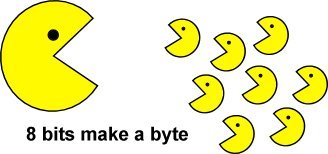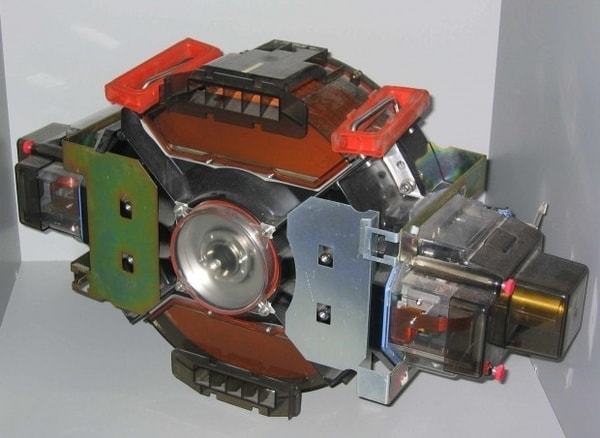Gigabyte history
- Transfer
We were going to publish a serious article on comparing the price policies of cloud providers, but decided that the New Year's Eve is not the best time for this, so today's article is more for fun than for serious thought. When today any of us thinks about storing personal data, the easiest way for him to think is in gigabyte categories. Your phone must have a memory of more than 16 gigabytes (GB) for storing all photos (using iCloud or Google drive, recording contacts, and so on ...), your laptop must have at least 4 GB of RAM and 250 GB of hard disk space to be considered worthy. Everyone just does what they say about gigabytes. And there is a reason.
Yesterday's version of a terabyte can rightfully be considered a gigabyte. Having 10 GB of storage not so long ago was considered sufficient to store all the data until the end of their days.

Photo source: pinterest.com
Now everything has changed, and even in the keychain there is more than 2 gigabytes of space, and there is such a means of storage as a
But why? What has changed so much in the storage world to reduce the value of a once powerful gigabyte to the cost of a cheap candy? Take a look at the history of gigabytes.
What is a gigabyte?
It makes no sense to talk about the history of a gigabyte without saying what it is. For most, this information may be superfluous (then just skip this section).
It is known that one gigabyte is equal to 1,000,000,000 bytes (the prefix "gigabyte" means 10⁹, according to the international system of units). Surprisingly, gigabytes also have a second definition: 1,073,741,824 bytes. How can one concept mean two completely different numbers? The point is the decimal and binary system.

On the decimal system, 1 GB = 1,000,000,000 bytes. This definition is commonly used to determine the size of a hard disk and the data transfer speed. In a binary system, 1 GB = 1,073,741,824 bytes, and this equality is used to denote the amount of RAM, or RAM.
Photo Source:
Any average user is confused by the situation when he buys a Windows computer with a 500 GB hard drive, and when he arrives home he discovers only 465 GB available, and, of course, considers himself deceived. But this is just a digit in the binary system!
To fix this, the international system of quantities standardized binary prefixes and equated them to 1024. With this prefix, 1 GB is approximately equal to 1 gigabyte.
What is gibibyte?
From this point on, everything becomes somewhat more confusing. Note that this paragraph is just for fun, because no one uses gibytes, although they can come in handy.
1 GB equals approx. 1.074 gib, approximately enough that the equality of 1 gigabyte = 1 gibyte
So, returning to a computer with a 500 GB hard drive, it’s worth considering that the calculation is in gigabytes, but the consumer understands the standard gigabyte, and not such ephemeral values.
History tour
 This picture is from the recent past, and it has already appeared in one of our articles. This is the year 1956, the hard drive for the IBM computer 305 RAMAC. It weighs more than a ton and can store only 5 megabytes (MB).
This picture is from the recent past, and it has already appeared in one of our articles. This is the year 1956, the hard drive for the IBM computer 305 RAMAC. It weighs more than a ton and can store only 5 megabytes (MB). 
Next came hard drives like the one we see below: the world's first 1 GB hard drive, the IBM 3380 HAD, in the photo below.
Photo Source: numbersleuth.org
This hard drive was used for a computer in 1980, and the computer itself was the size of a refrigerator. So, it took us 23 years to go from 5 MB to 1 GB, and what happens in 2003? What was the total size of the personal storage device at that time? In 2003, Serial ATA was invented with increased write and data transfer rates that reduce size and cost. Not surprisingly, the average hard drive size in 2003 was around 150–250 GB.
Photo source: aphelis.net
Today it’s quite difficult to find a computer with less than 1 terabyte (1000 GB) of hard disk space (by the way, laptops still catch up and catch up).
Storage cost
All of these data bytes should cost money. Storage volumes and prices are developing inversely proportional - what else can I say? Take a look at the chart below.

Photo Source: mkomo.com
This is absolutely unbelievable. Over 35 years ago, the cost of 1 GB decreased from $ 1 million to $ 0.05. Awesome.
Future storage
As you know, the era of physical means of information storage is coming to an end. Moore's Law. The heyday of the cloud and the ability to transfer what we used to download, changed the idea of storage, and gigabytes today no longer have the same value as before. A decrease in attention to memory size occurs with a simultaneous increase in the importance of transmission speed.
And although the days of a megabyte have passed, it seems that a gigabyte
